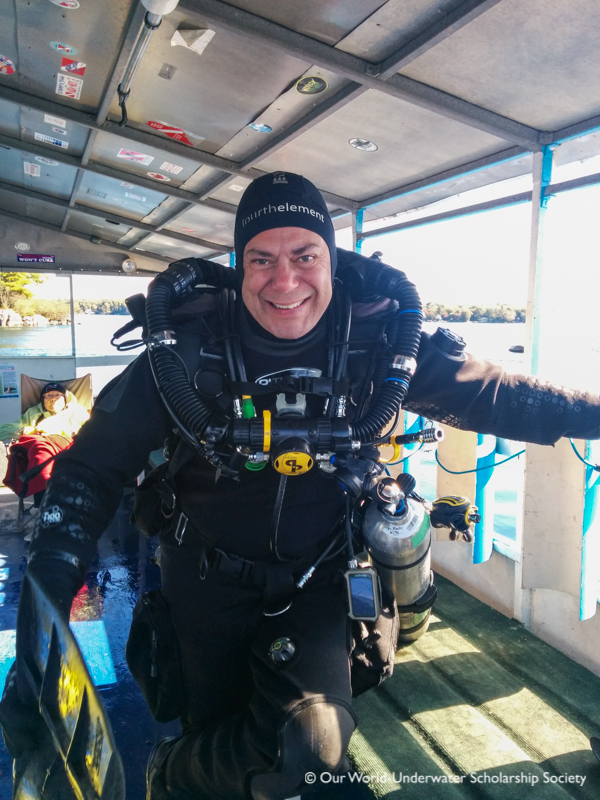———————————
Be sure to follow the new European Rolex Scholar Facebook page for more regular updates on my adventures and those of future EU scholars. 😀
———————————
If you ask a bunch of divers why they enjoy diving, you will likely get a variety of different answers. But I’m positive that one of the most common, recurring responses will go something along the lines of “I just love how quiet it is down there.”
Silence. It’s definitely a big plus point to scuba diving, at least it is for me. But when you think about it, conventional open circuit scuba diving that we all know and love isn’t really silent. Not truly anyway. There’s always the sound of your regulator releasing air as you inhale, and the sound of the bubbling CO2 scurrying for the surface as you exhale. In reality, it’s actually pretty darn noisy! Well that all changed for me during my most recent scholarship adventure.
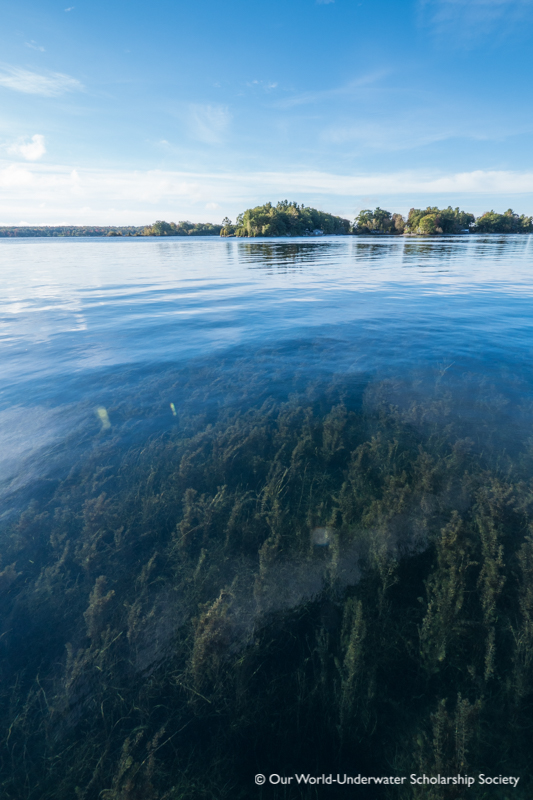
Following the heat and sunshine of my month in the Maldives, it was time to don my sexy Apeks KVR1 drysuit once more and head to cooler climes – more specifically, Ontario, one of the ten enormous provinces that make up Canada.
(Seriously, this province is maybe twice the size of the UK. It’s stupidly big).
Here I was to spend several days diving in the waters of the Saint Lawrence River, where I would get to see some of the best freshwater wrecks in the world. Pretty awesome stuff, I hear you say. Yes, yes it was awesome. But let’s not rush ahead just yet. We need some context here!
My dive buddy to-be was Mike Fowler – a fellow Brit, rugby-world-cup fan, and lover of bacon, who calls the City of Brockville his home. Whilst I was definitely stoked to see Ontario’s wrecks, the local metal wasn’t actually the primary reason for my visit to Canada. First and foremost, I was here to learn an entirely new set of dive skills. Mike specialises in teaching divers how to use Closed-Circuit Rebreathers (CCR), and along with support from TDI: Technical Diving International, he was going to run me through a crash course in using the AP Inspiration CCR!
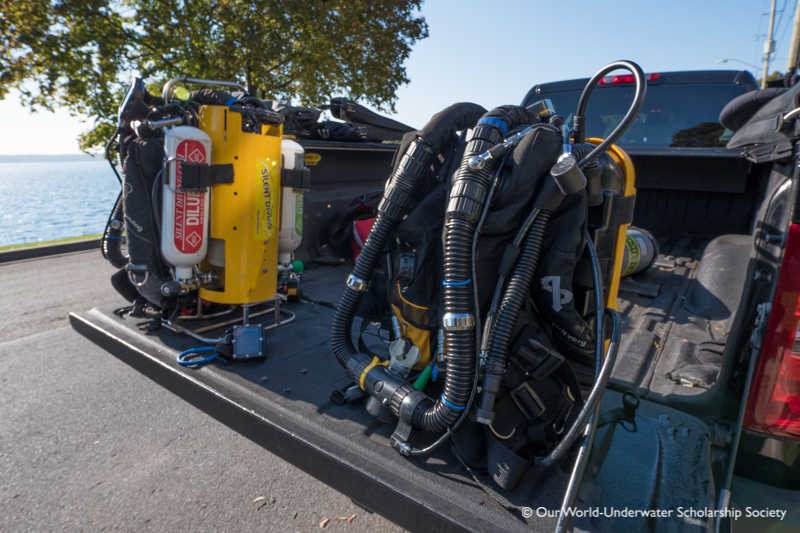
I couldn’t wait to get started. Ever since I started the scholarship year, I knew I wanted to learn how to dive a CCR unit. Whilst recreational diving will always be the realm of open circuit (in my opinion), it’s becoming increasingly apparent that CCRs are playing an ever-bigger role in the UW media and marine science world. Diving a unit and having a working knowledge of rebreathers in general was a skill I knew would be important no matter where my diving career takes me post-scholarship. And whilst there is a plethora of different CCR units out there, and an equal number of opinions as to which ones are the ‘best’, my reasons and situation led me to the AP Inspiration units. Mike, having taught many post Rolex scholars including Ana, Jeff Hester and even my NA-2015 sister, Michele, was the obvious man to turn to for tuition. Lucky for me, Mike is far too generous and was more than happy to help me out!
The first few days consisted of a mixture of theory and some practical workshops as Mike walked me through the basics of how to set up and run the Inspiration rebreather. I won’t lie, it was all a little overwhelming at first. The way rebreathers work is fundamentally more complex than your standard open circuit scuba gear. Whilst you can throw together the latter in a few short minutes, the former requires a far more methodical and systematic approach. In the early stages, despite having a nice, clear set of instructions to guide me through the process of preparing the unit, I was constantly worried that I was forgetting stuff, damaging something, or just generally doing it all wrong! Was I possibly overthinking everything? Absolutely.
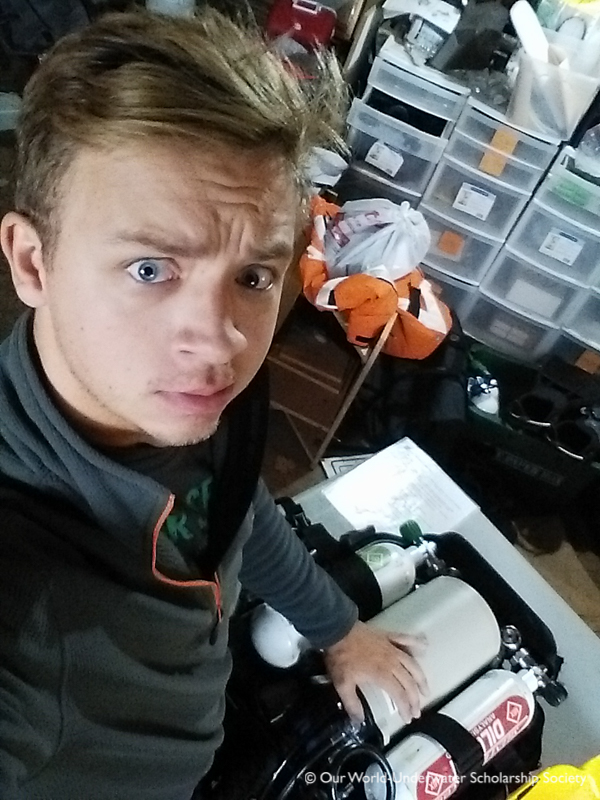
Thankfully Mike was quick to put to rest any qualms I had, and it wasn’t long before disassembling, cleaning and reassembling the unit became easier and easier. Once I got over the initial burn of new-information-overload, it actually proved to be quite a simple and straight forward process to work and prepare these machines. By the week’s end, I was setting things up and packing things away nearly as fast as Mike (okay….possibly an exaggeration. For any of you that know me, you know that fast and Danny don’t ever go together).
Anyway, of all the things I learnt throughout the week during our time between dives on dry-land, perhaps the most important lesson was that rebreathers really aren’t unsafe at all. All the scare-mongering and horror stories that have you think that rebreathers are the devil-incarnate are completely misleading. Units like the AP Inspirations are actually extremely safe. The reality is that the biggest safety concern and cause of incidents in rebreather diving is not the units themselves, but the numpties that misuse them and don’t follow the rules and guidelines properly. The take home message was pretty clear from the get-go. Don’t become complacent with your checks, follow the rules, and understand the unit and how to plan for and deal with small problems in the unlikely event that they arise.
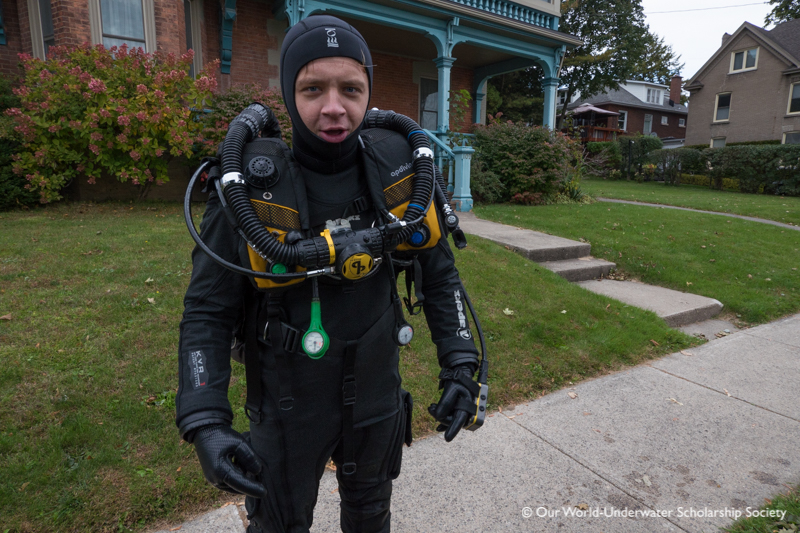
The second important, and perhaps most humbling of lessons came to me during our first few shore dives in the Saint Lawrence River. As we sank below the surface, I couldn’t help but flail and list from side to side like a leaky yacht in a storm. Sometimes I just straight up crashed into the river bed, in spectacular fashion! In hindsight, it was hilarious. But at the time, the feeling of not knowing how to control my buoyancy was unfamiliar and, frankly, more than a little frustrating! A consequence of the physics surrounding how CCR works, my lovely buoyancy skills and trim that I had developed over the last 300 dives on open circuit had gone flying out of the window. Fine-tuning your buoyancy with your lungs doesn’t apply here. In addition to a drysuit and BCD, you’ve now got counter-lungs as an extra buoyancy device to deal with. In short, my buoyancy now sucked. Immensely. Everything was different. Everything was unfamiliar. More often than not, everything was opposite to what I knew from open circuit. Mike had forewarned me before I got in the water, but I didn’t expect it to be such a dramatic difference. It quickly became clear that I had become an entry-level student all over again. This was a completely different form of scuba diving, and I would have to learn the basics from scratch.

But thankfully by the end of the first few hours on CCR, I was starting to get the hang of it, and as the week went on I felt more and more comfortable and ‘at-one’ with the unit. Despite what I thought, Mike was complementing me on my trim and buoyancy skills from day one – so much so, that we wasted no time cracking on with diving the Saint Lawrence and all its wrecks in earnest, practicing CCR skills bit-by-bit as we progressed through the week. With the help of Helen, Vincent and the gang at Dive Brockville Adventure Centre, Mike and I were able to dive eight different wrecks over the course of the week.
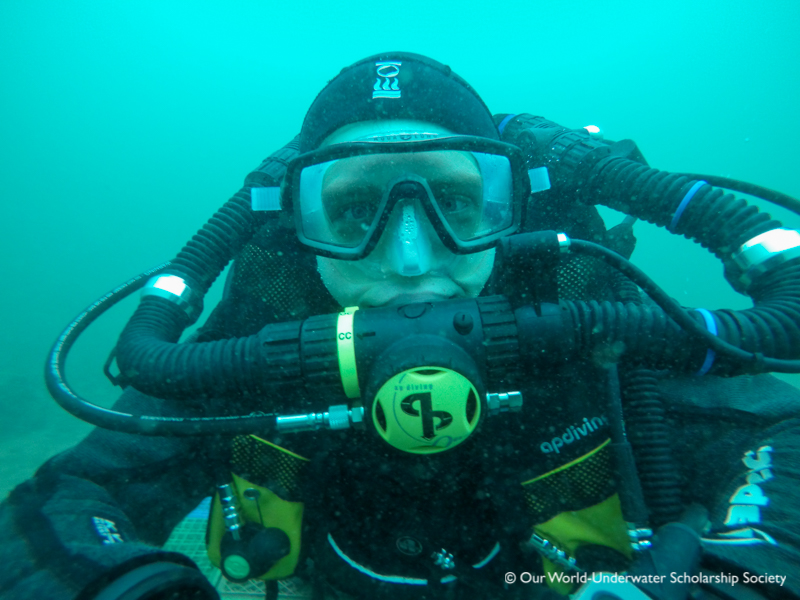
Those of you that know me or have read many of my previous blogs will know that I am an aquatic-life sort of guy first, wreck-loving metal-head second – maybe even third after caverns. But just like the SS Thistlegorm and the wrecks in the Red Sea, the wrecks of the Ontario couldn’t help but impress! Most wreck dives in the UK are…well….mostly wreckage to be honest. You go down the shot-line and find a pile of metal, maybe finding a conger eel somewhere amongst the debris. But here, in the Saint Lawrence, oh-ho was I in for a break from the norm! All the wrecks actually look…well….like wrecks! Actual boats and ships that people did stuff on. Seriously cool.
What’s more is that many of these wrecks are old….like, pretty damn old by my standard. Like, 19th century sort of stuff. And as such, many are made entirely, or mostly, from wood. And yet there they were, still in a condition the rival even the young and resilient modern war wrecks of Europe.
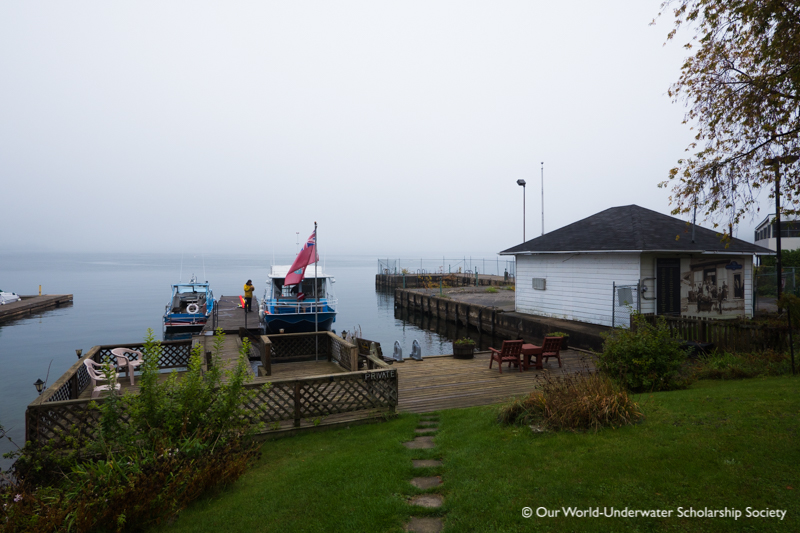
Of all the wrecks we dived, perhaps my favourite was the Lillie Parsons, a white-oak schooner that sank in 1877 (damn, that’s old!) and now rests upside down in a gully. As a result of her resting place, she experiences some pretty hefty currents of 2-3 knots, and as such essentially doubles as two dives in one. Descend down the line, explore the wreck and once you’re done, kick off into open water and go for one hell of a drift dive!

Mike and I did this dive twice during the week. The first dive we explored the peripheries of the wreck, getting our faces up close and personal with dozens of Black Bass and Walleye (my Zoology-ness rejoiced!) before blitzing along in the drift, swooping around immense walls of granite rock encrusted in zebra-muscles from top-to-bottom. I don’t know why, but in the gloom it felt like we were flying by some epic, moody cliffs in a movie about mythical creatures in Ancient Greece / Sparta (don’t worry, Mike didn’t get where I was coming from either). A particular highlight came in the form of a mahoosive 6ft Lake Sturgeon that passed beneath us! What with this pretty wreck and all the life…and space…I had to remind myself we were in a freshwater river and not out off the coast somewhere. Insanely cool dive.
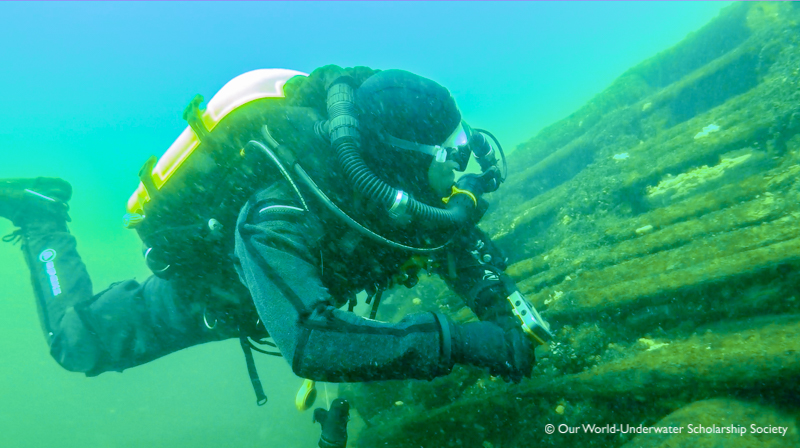
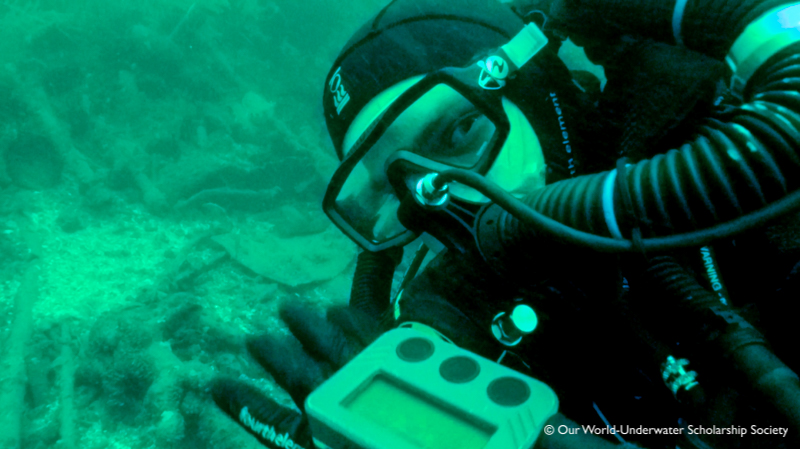
We returned later in the week once my buoyancy skills had reached peak levels of not-sucking, and decided to sneak up and into the upside-down wreck. Mike and I swam down the ‘halls’ of the ancient hull in slightly silty darkness, single file, navigating our way around bars of broken wood and wreckage. It was pretty incredible, most notably because of one thing in particular. Silence. Absolute, uninteruppted silence. I had never experienced that underwater. It created such an insane, ominous and gloomy feel. Fish swimming around you in a ‘cavern’ of timber deep in the bowels of a wreck. As with many of our dives, Mike and I were the only ones there. Both on our rebreathers. It was hauntingly quiet…and one of the coolest cold-water dives I’ve ever done!
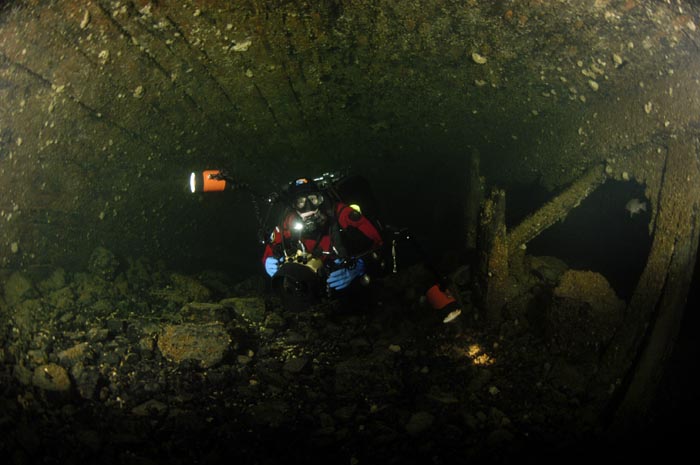
I’d like to thank Mike Fowler, Helen, Vincent, the gang from TDI for helping make this week happen. Not only have I gained an entirely new diving skill set on the AP Inspiration, but my time in Ontario also left me with some of the best wreck diving and freshwater dives I’ve ever experienced! It was an incredible week, filled with diving, bacon, rugby, diving, bacon, BBQ chicken, and a quick viewing of The Martian. Mike was such an awesome host, and I can’t thank him enough for putting up with me and introducing me to the world of CCR diving. I cannot wait to return one day – nor can I wait until the next time I get to dive on CCR.
Yeah, safe to say I’m hooked!
